
Am Fam Physician. 2011;83(9):1057-1063
Patient information: See related handout on sinus infections, written by the authors of this article.
Author disclosure: Nothing to disclose.
Rhinosinusitis is one of the most common conditions for which patients seek medical care. Subtypes of rhinosinusitis include acute, subacute, recurrent acute, and chronic. Acute rhinosinusitis is further specified as bacterial or viral. Most cases of acute rhinosinusitis are caused by viral infections associated with the common cold. Symptomatic treatment with analgesics, decongestants, and saline nasal irrigation is appropriate in patients who present with nonsevere symptoms (e.g., mild pain, temperature less than 101°F [38.3°C]). Narrow-spectrum antibiotics, such as amoxicillin or trimethoprim/sulfamethoxazole, are recommended in patients with symptoms or signs of acute rhinosinusitis that do not improve after seven days, or that worsen at any time. Limited evidence supports the use of intranasal corticosteroids in patients with acute rhinosinusitis. Radiographic imaging is not recommended in the evaluation of uncomplicated acute rhinosinusitis. Computed tomography of the sinuses should not be used for routine evaluation, although it may be used to define anatomic abnormalities and evaluate patients with suspected complications of acute bacterial rhinosinusitis. Rare complications of acute bacterial rhinosinusitis include orbital, intracranial, and bony involvement. If symptoms persist or progress after maximal medical therapy, and if computed tomography shows evidence of sinus disease, referral to an otolaryngologist is warranted.
Sinusitis is one of the most common conditions treated by primary care physicians. Each year in the United States, sinusitis affects one in seven adults, and is diagnosed in 31 million patients.1 The direct costs of sinusitis, including medications, outpatient and emergency department visits, and ancillary tests and procedures, are estimated to be $3 billion per year in the United States.1,2 Sinusitis is the fifth most common diagnosis for which antibiotics are prescribed.1,2
| Clinical recommendation | Evidence rating | References |
|---|---|---|
| Radiographic imaging in patients with acute rhinosinusitis is not recommended unless a complication or an alternative diagnosis is suspected. | C | 1, 9, 10 |
| Antibiotic therapy is recommended for patients with rhinosinusitis symptoms that do not improve within seven days or that worsen at any time; those with moderate illness (moderate to severe pain or temperature ≥ 101°F [38.3°C]); or those who are immunocompromised. | B | 1, 11–13 |
| Amoxicillin is considered the first-line antibiotic for most patients with acute bacterial rhinosinusitis. | A | 1, 13 |
| Trimethoprim/sulfamethoxazole (Bactrim, Septra) and macrolide antibiotics are reasonable alternatives to amoxicillin for treating acute bacterial rhinosinusitis in patients who are allergic to penicillin. | C | 1 |
| Mild rhinosinusitis symptoms of less than seven days' duration can be managed with supportive care, including analgesics, short-term decongestants, saline nasal irrigation, and intranasal corticosteroids. | A | 1, 18, 31 |
Definition
Inflammation of the sinuses rarely occurs without concurrent inflammation of the nasal mucosa; therefore, rhinosinusitis is a more accurate term for what is commonly called sinusitis. The American Academy of Otolaryngology–Head and Neck Surgery defines subtypes of rhinosinusitis based on the duration of symptoms: acute, subacute, recurrent acute, and chronic (Table 1).1,3,4 Acute rhinosinusitis is further categorized as bacterial or viral.
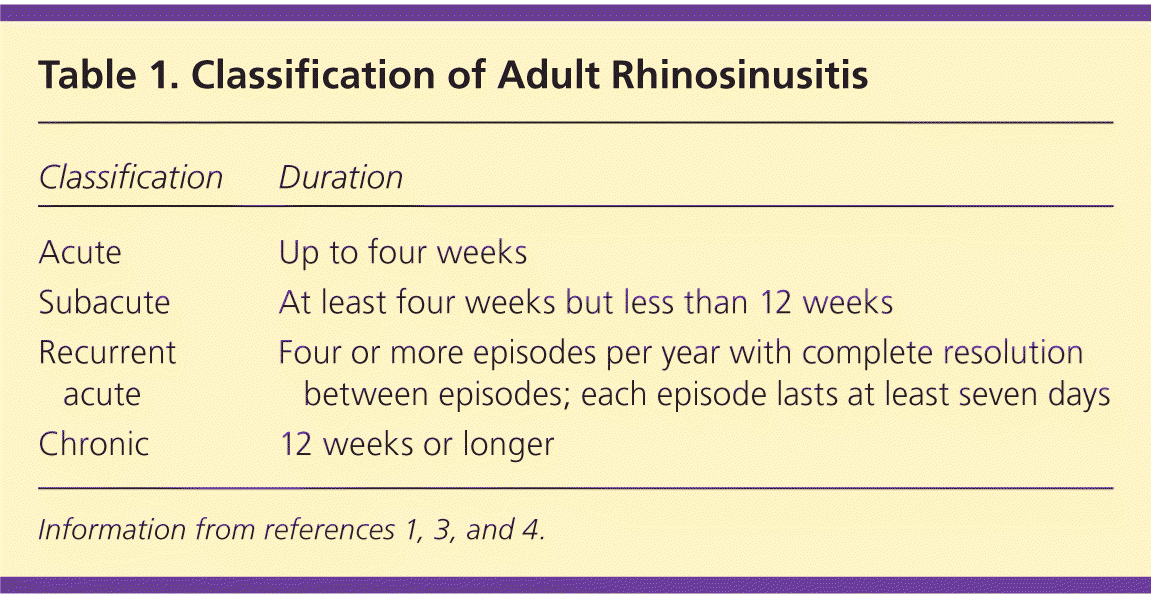
| Classification | Duration |
|---|---|
| Acute | Up to four weeks |
| Subacute | At least four weeks but less than 12 weeks |
| Recurrent acute | Four or more episodes per year with complete resolution between episodes; each episode lasts at least seven days |
| Chronic | 12 weeks or longer |
Etiology
Most cases of acute rhinosinusitis are caused by viral infections associated with the common cold. Mucosal edema leads to obstruction of the sinus ostia. In addition, viral and bacterial infections impair the cilia, which transport mucus. The obstruction and slowed mucus transport cause stagnation of secretions and lowered oxygen tension within the sinuses. This environment is an excellent culture medium for viruses and bacteria. The most common bacterial organisms in community-acquired acute bacterial rhinosinusitis are Streptococcus pneumoniae, Haemophilus influenzae, Staphylococcus aureus, and Moraxella catarrhalis.5 The most common viruses in acute viral rhinosinusitis are rhinovirus, adenovirus, influenza virus, and parainfluenza virus.
Diagnosis
The signs and symptoms of acute bacterial rhinosinusitis and prolonged viral upper respiratory infection are similar, which can lead to overdiagnosis of acute bacterial rhinosinusitis. The presence of purulent nasal drainage is not the sole criterion to distinguish between viral and bacterial infection1,6; the pattern and duration of illness are also key. In most patients, viral rhinosinusitis improves in seven to 10 days. Diagnosis of acute bacterial rhinosinusitis requires that symptoms persist for longer than 10 days or worsen after five to seven days.1,3,5,7
The American Academy of Otolaryngology–Head and Neck Surgery and the American College of Physicians have proposed diagnostic criteria for sinusitis.1,2,5,8 The American College of Physicians' criteria were endorsed by the Centers for Disease Control and Prevention, the Infectious Diseases Society of America, and the American Academy of Family Physicians. Table 2 lists the sensitivity and specificity of criteria used to diagnose rhinosinusits.5 Bacterial culture of secretions may be used when resistant pathogens are suspected or if the patient is immunocompromised.9
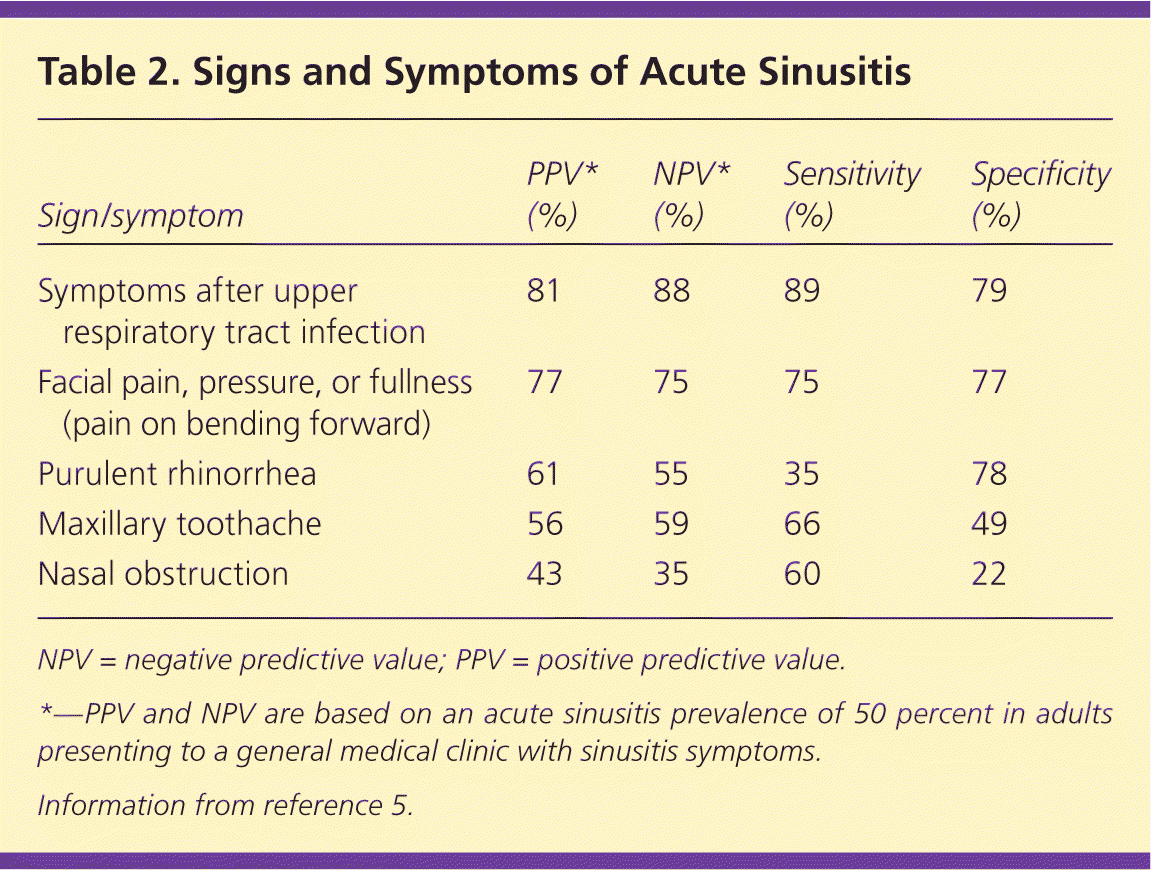
Imaging
Radiographic imaging is not recommended for evaluating uncomplicated acute rhinosinusitis.1,3–5,9 Plain sinus radiography cannot be used to distinguish between bacterial and viral etiologies; air-fluid levels are visible in patients with viral or bacterial rhinosinusitis.1,10 Sinus computed tomography should not be used for routine evaluation of acute bacterial rhinosinusitis, but it can define anatomic abnormalities and identify suspected complications. Magnetic resonance imaging can be used to identify suspected tumors or fungal sinusitis, which may involve adjacent soft tissue structures.
Antibiotic Therapy
Antibiotics may be considered in patients with symptoms or signs of acute rhinosinusitis that do not improve within seven days or that worsen at any time; in those with moderate to severe pain or a temperature of 101°F (38.3°C) or higher; and in those who are immunocompromised.1 In a systematic review of 13 randomized trials of antibiotic use in adults with acute rhinosinusitis, more than 70 percent clinically improved after seven days, with or without antibiotic therapy.11 Complete clinical cure without antibiotics occurred in 8 percent of patients within three to five days, in 35 percent within seven to 12 days, and in 45 percent within 14 to 15 days. Antibiotic use increased the absolute cure rate by 15 percent compared with placebo at seven to 12 days (number needed to treat = 7). At 14 to 15 days, antibiotic therapy was no longer beneficial. Adverse effects occurred more often with antibiotic use than with placebo (number needed to harm = 9). Common adverse effects included diarrhea, nausea, vomiting, skin rash, vaginal discharge, and headache.
Other meta-analyses found a small treatment effect in favor of antibiotic use, with a corresponding increase in adverse effects.12,13 In one randomized, double-blind clinical trial, no improvement was seen with antibiotic use at 14 days compared with placebo.14 However, in a subgroup analysis of those who recovered completely, the mean number of days to improvement was 8.1 for the antibiotic group versus 10.7 for the placebo group.14
Many studies evaluating antibiotic use in patients with rhinosinusitis exclude those with severe illness. A meta-analysis based on individual patient data found that common clinical signs and symptoms did not identify patients with rhinosinusitis who benefit from antibiotics.15 However, high fever, periorbital swelling, erythema, and intense facial pain are indicative of a serious complication that should be treated promptly with antibiotics. In addition, patients' age, general health, cardiopulmonary status, and comorbid conditions are important considerations for early initiation of antibiotic therapy.1
CHOOSING AN ANTIBIOTIC
Antibiotic options for treating acute bacterial rhinosinusitis are outlined in Table 3.2 Most guidelines recommend amoxicillin as first-line therapy because of its safety, effectiveness, low cost, and narrow microbiologic spectrum. For patients allergic to penicillin, trimethoprim/sulfamethoxazole (Bactrim, Septra) or a macrolide may be used as an alternative to amoxicillin.1
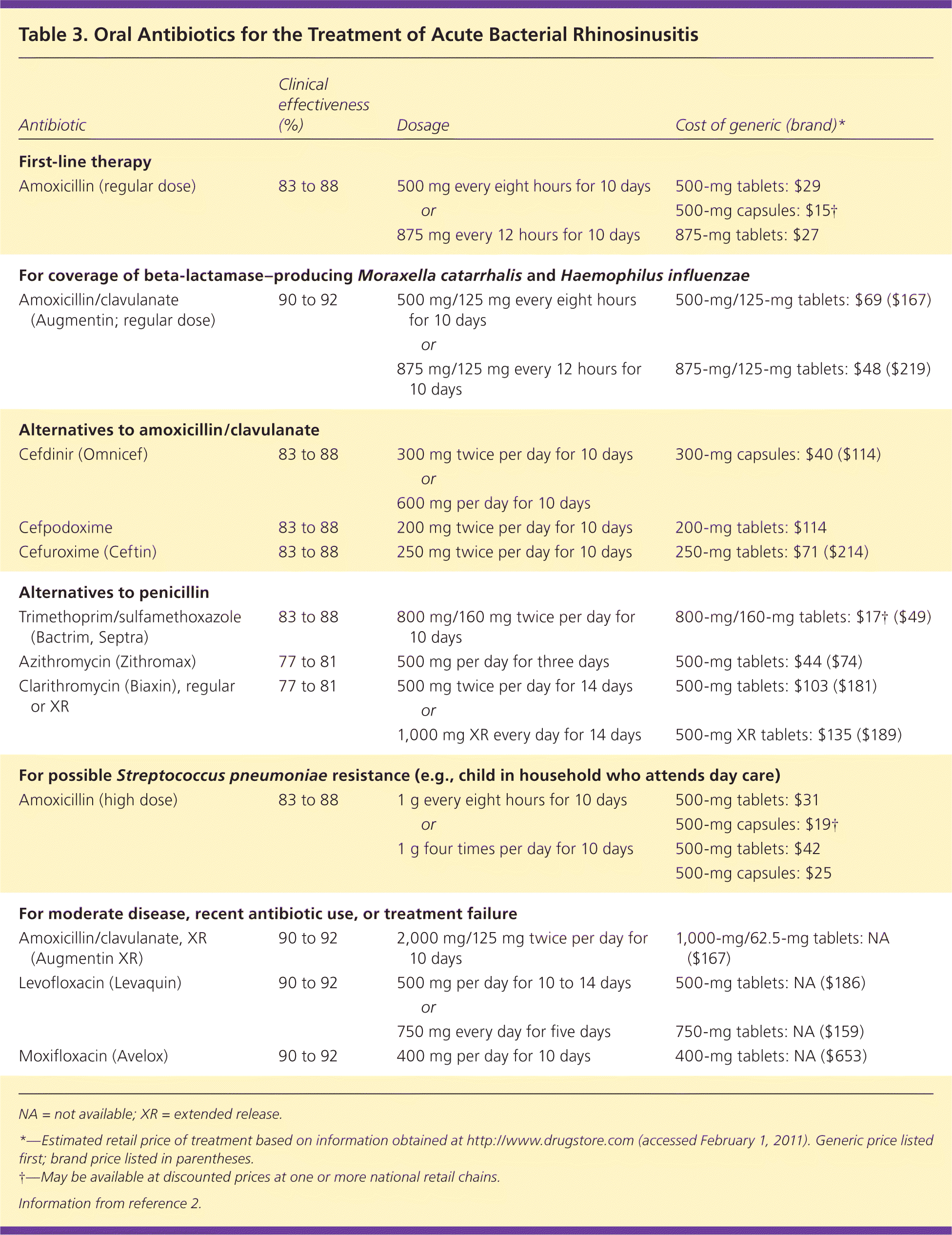
| Antibiotic | Clinical effectiveness (%) | Dosage | Cost of generic (brand)* | |
|---|---|---|---|---|
| First-line therapy | ||||
| Amoxicillin (regular dose) | 83 to 88 | 500 mg every eight hours for 10 days | 500-mg tablets: $29 | |
| or | 500-mg capsules: $15† | |||
| 875 mg every 12 hours for 10 days | 875-mg tablets: $27 | |||
| For coverage of beta-lactamase–producing Moraxella catarrhalis and Haemophilus influenzae | ||||
| Amoxicillin/clavulanate (Augmentin; regular dose) | 90 to 92 | 500 mg/125 mg every eight hours for 10 days | 500-mg/125-mg tablets: $69 ($167) | |
| or | ||||
| 875 mg/125 mg every 12 hours for 10 days | 875-mg/125-mg tablets: $48 ($219) | |||
| Alternatives to amoxicillin/clavulanate | ||||
| Cefdinir (Omnicef) | 83 to 88 | 300 mg twice per day for 10 days | 300-mg capsules: $40 ($114) | |
| or | ||||
| 600 mg per day for 10 days | ||||
| Cefpodoxime | 83 to 88 | 200 mg twice per day for 10 days | 200-mg tablets: $114 | |
| Cefuroxime (Ceftin) | 83 to 88 | 250 mg twice per day for 10 days | 250-mg tablets: $71 ($214) | |
| Alternatives to penicillin | ||||
| Trimethoprim/sulfamethoxazole (Bactrim, Septra) | 83 to 88 | 800 mg/160 mg twice per day for 10 days | 800-mg/160-mg tablets: $17† ($49) | |
| Azithromycin (Zithromax) | 77 to 81 | 500 mg per day for three days | 500-mg tablets: $44 ($74) | |
| Clarithromycin (Biaxin), regular or XR | 77 to 81 | 500 mg twice per day for 14 days | 500-mg tablets: $103 ($181) | |
| or | ||||
| 1,000 mg XR every day for 14 days | 500-mg XR tablets: $135 ($189) | |||
| For possibleStreptococcus pneumoniaeresistance (e.g., child in household who attends day care) | ||||
| Amoxicillin (high dose) | 83 to 88 | 1 g every eight hours for 10 days | 500-mg tablets: $31 | |
| or | 500-mg capsules: $19† | |||
| 1 g four times per day for 10 days | 500-mg tablets: $42 | |||
| 500-mg capsules: $25 | ||||
| For moderate disease, recent antibiotic use, or treatment failure | ||||
| Amoxicillin/clavulanate, XR (Augmentin XR) | 90 to 92 | 2,000 mg/125 mg twice per day for 10 days | 1,000-mg/62.5-mg tablets: NA ($167) | |
| Levofloxacin (Levaquin) | 90 to 92 | 500 mg per day for 10 to 14 days | 500-mg tablets: NA ($186) | |
| or | ||||
| 750 mg every day for five days | 750-mg tablets: NA ($159) | |||
| Moxifloxacin (Avelox) | 90 to 92 | 400 mg per day for 10 days | 400-mg tablets: NA ($653) | |
A systematic review found no notable differences in clinical outcomes for patients with acute bacterial rhinosinusitis who were treated with amoxicillin compared with cephalosporins and macrolides.13 Newer fluoroquinolones conferred no benefit over betalactam antibiotics and are not recommended as first-line agents.16
DURATION OF THERAPY
TREATMENT FAILURE
Treatment failure occurs when symptoms progress during treatment or do not improve after seven days of therapy. A nonbacterial cause or an infection with drug-resistant bacteria should be considered. If symptoms do not improve with amoxicillin therapy, or if there is symptom relapse within six weeks, an alternative antibiotic with a broader spectrum is required. High-dose amoxicillin/clavulanate (Augmentin) or a respiratory fluoroquinolone may be considered. In refractory cases, referral to an otolaryngologist may be needed.1
Adjunctive Therapies
Nonsevere symptoms (e.g., mild pain, temperature less than 101° F) of less than seven days' duration may be managed with supportive care.1 Adjunctive therapies that have been investigated for symptomatic relief of acute bacterial rhinosinusitis include analgesics, decongestants, antihistamines, saline nasal irrigation, mucolytics, and intranasal corticosteroids. Table 4 summarizes adjunctive treatment therapies.
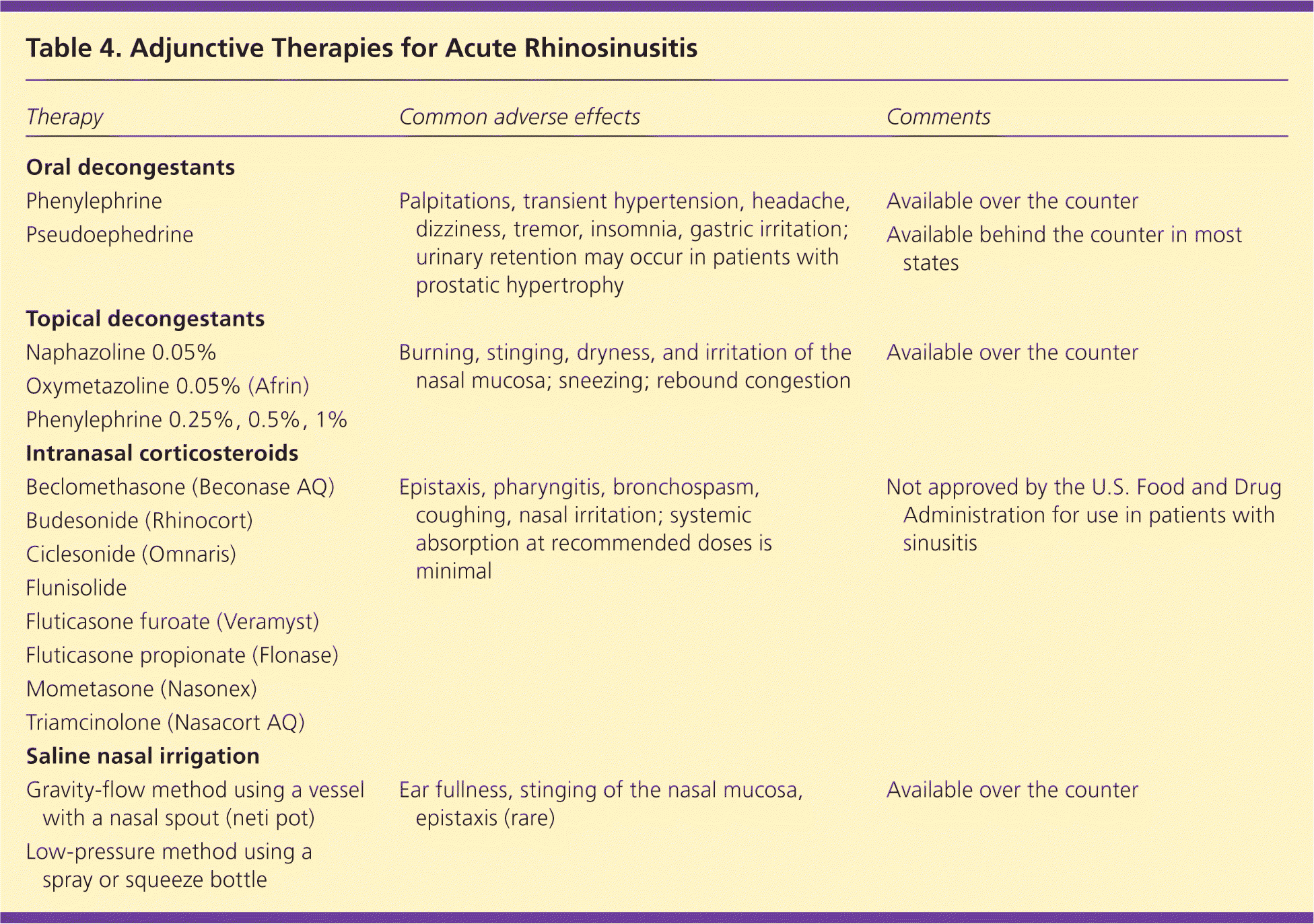
| Therapy | Common adverse effects | Comments | ||
|---|---|---|---|---|
| Oral decongestants | ||||
| Phenylephrine | Palpitations, transient hypertension, headache, dizziness, tremor, insomnia, gastric irritation; urinary retention may occur in patients with prostatic hypertrophy | Available over the counter | ||
| Pseudoephedrine | Available behind the counter in most states | |||
| Topical decongestants | ||||
| Naphazoline 0.05% | Burning, stinging, dryness, and irritation of the nasal mucosa; sneezing; rebound congestion | Available over the counter | ||
| Oxymetazoline 0.05% (Afrin) | ||||
| Phenylephrine 0.25%, 0.5%, 1% | ||||
| Intranasal corticosteroids | ||||
| Beclomethasone (Beconase AQ) | Epistaxis, pharyngitis, bronchospasm, coughing, nasal irritation; systemic absorption at recommended doses is minimal | Not approved by the U.S. Food and Drug Administration for use in patients with sinusitis | ||
| Budesonide (Rhinocort) | ||||
| Ciclesonide (Omnaris) | ||||
| Flunisolide | ||||
| Fluticasone furoate (Veramyst) | ||||
| Fluticasone propionate (Flonase) | ||||
| Mometasone (Nasonex) | ||||
| Triamcinolone (Nasacort AQ) | ||||
| Saline nasal irrigation | ||||
| Gravity-flow method using a vessel with a nasal spout (neti pot) | Ear fullness, stinging of the nasal mucosa, epistaxis (rare) | Available over the counter | ||
| Low-pressure method using a spray or squeeze bottle | ||||
ANALGESICS
Analgesic treatment is often necessary for patients to relieve pain, get adequate rest, and resume normal activities. Selection of analgesics should be based on the severity of pain. Acetaminophen or a nonsteroidal anti-inflammatory drug given alone or in combination with an opioid is appropriate for mild to moderate pain.1
DECONGESTANTS
A decongestant may be used to reduce mucosal edema and facilitate aeration and drainage during acute episodes. The effect of decongestants in the nasal cavity, however, does not extend to the paranasal sinuses.17 There are no RCTs that evaluate the effectiveness of decongestants in patients with sinusitis. In a systematic review of seven studies, nasal decongestants were found to be modestly effective for short-term relief of congestion in adults with the common cold.18 Topical decongestants should not be used longer than three days because of the risk of rebound nasal congestion (rhinitis medicamentosa).
ANTIHISTAMINES
Antihistamines are often used to relieve symptoms because of their drying effect. However, there are no studies to support their use in the treatment of acute sinusitis. According to a Cochrane review, antihistamines do not significantly alleviate nasal congestion, rhinorrhea, or sneezing in persons with the common cold.19 Antihistamines may complicate drainage by over-drying the nasal mucosa, leading to further discomfort. Therefore, antihistamines should not be used for symptomatic relief of acute sinusitis except in patients with a history of allergy.1
SALINE NASAL IRRIGATION
Nasal irrigation with saline may be used to soften viscous secretions and improve mucociliary clearance. The mechanical cleansing of the nasal cavity with saline has been shown to benefit patients with chronic rhinosinusitis and frequent sinusitis.20,21 Evidence supporting the use of nasal saline irrigation for acute upper respiratory tract infections is less conclusive. A Cochrane review found three small trials showing limited benefit for symptom relief with nasal saline irrigation in adults.22 Nevertheless, nasal irrigation is a safe and inexpensive treatment option for patients seeking symptom relief.1,23
MUCOLYTICS
Guaifenesin, a mucolytic, has been used to thin mucus and improve nasal drainage. However, because it has not been evaluated in clinical trials, guaifenesin is not recommended as an adjunct treatment for rhinosinusitis.1
CORTICOSTEROIDS
Intranasal corticosteroids reduce inflammation and edema of the nasal mucosa, nasal turbinates, and sinus ostia. There are no controlled trials supporting the use of systemic corticosteroids for the treatment of acute bacterial rhinosinusitis. Intranasal corticosteroids are minimally absorbed and have a low incidence of systemic adverse effects. Most studies on intranasal corticosteroid use in patients with acute sinusitis are industry sponsored. These studies suggest that intranasal corticosteroids provide additional benefit in symptom improvement when used with antibiotics.24–30 The data on intranasal corticosteroid monotherapy for acute sinusitis are limited. A Cochrane review examined four RCTs with 1,943 patients.26–28,30 The authors concluded that although the current evidence is limited, it supports the use of intranasal corticosteroids as monotherapy or as adjuvant therapy to antibiotics in acute rhinosinusitis.31 However, another RCT found that antibiotics and intranasal corticosteroids, alone or in combination, were ineffective.32 This study suggested that intranasal corticosteroids may be effective in patients with less severe symptoms at baseline.32 Although intranasal corticosteroids are not approved for use in patients with acute rhinosinusitis, current guidelines consider them an option based on an individualized decision.1
Complications and Referral
If symptoms worsen or fail to improve with treatment, physicians should reevaluate the patient to confirm the diagnosis of acute bacterial rhinosinusitis, exclude other causes of illness, and detect complications.1,9,10 Complications of acute bacterial rhinosinusitis are estimated to occur in one in 1,000 cases.9 The orbit is the most common structure involved in complicated sinusitis and is usually caused by ethmoid sinusitis.9 Patients with acute bacterial rhinosinusitis who present with visual symptoms (e.g., diplopia, decreased visual acuity, disconjugate gaze, difficulty opening the eye), severe headache, somnolence, or high fever should be evaluated with emergent computed tomography with contrast media.9 Sinonasal cancers are uncommon, with an annual incidence of less than one in 100,000 in the United States, but should still be included in the differential diagnosis.10 Table 5 summarizes complications of acute sinusitis.7,9 Neurologic and neurosurgical consultation are advised for patients with intracranial complications. Ophthalmology referral is warranted for patients with orbital complications. In addition, if symptoms persist or progress after maximal medical therapy, and if computed tomography shows evidence of sinus disease, patients should be referred to an otolaryngologist.9,10,33
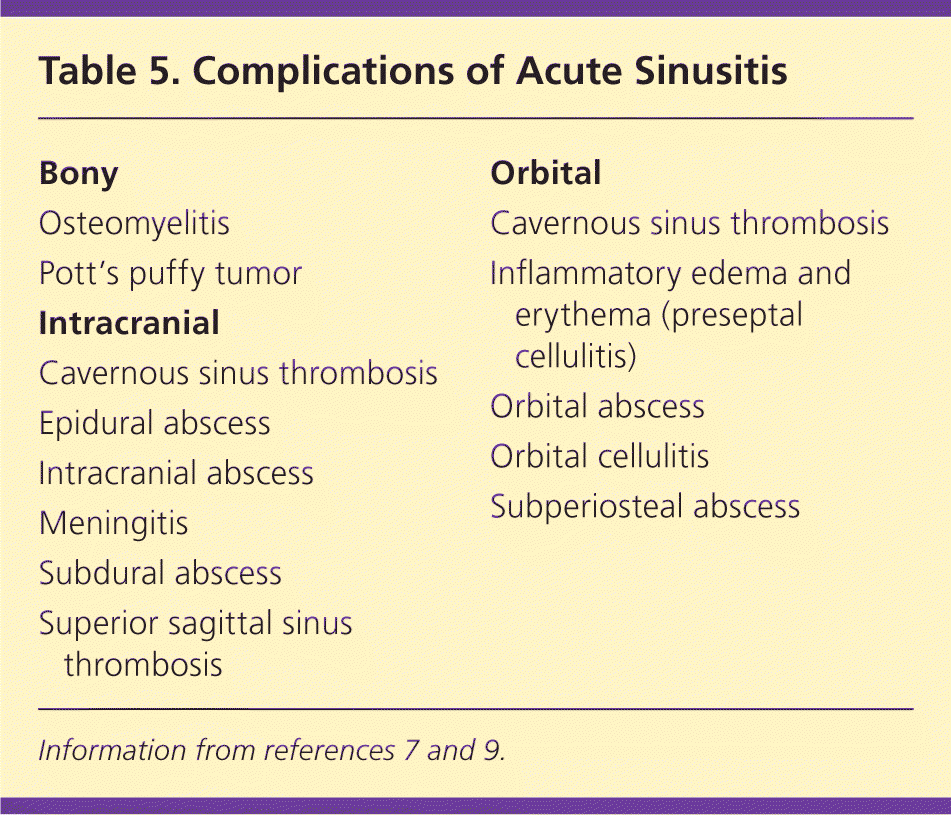
| Bony |
| Osteomyelitis |
| Pott's puffy tumor |
| Intracranial |
| Cavernous sinus thrombosis |
| Epidural abscess |
| Intracranial abscess |
| Meningitis |
| Subdural abscess |
| Superior sagittal sinus thrombosis |
| Orbital |
| Cavernous sinus thrombosis |
| Inflammatory edema and erythema (preseptal cellulitis) |
| Orbital abscess |
| Orbital cellulitis |
| Subperiosteal abscess |
